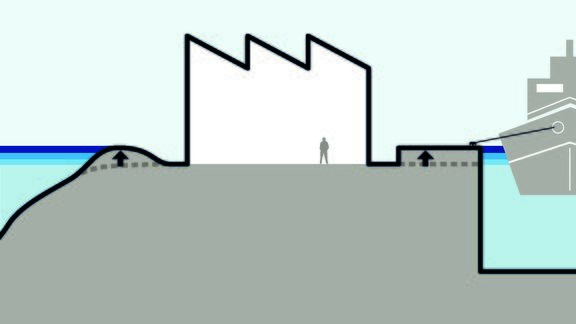Raising slopes and quay walls
Raising slopes and quay walls makes it less likely that an area will flood when water levels are high. This reduces the risk of economic and environmental damage and casualties behind these raised borders.
- Applicable to land;
- Preventive measure;
- Permanent measure;
- Major investment;
- Prevents economic and environmental damage, and casualties;
- Applicable at all flood depths.

Quay walls or slopes form the transitions between land and water on port sites. Raising or reinforcing them reduces the likelihood of flooding in the areas behind them.
Raising quay walls
Ships can moor alongside quay walls. When a quay wall is raised, the quay wall and possibly the loading and unloading area behind it are raised to the proper height. If necessary, the quay wall will be reinforced, for example with additional anchoring. To reduce the extra load on the quay wall, you can also opt for a narrow wall such as an L-wall.
Raising a quay wall may result in the interruption of business operations on the quay. You can apply the measure at locations where the flood risk is highest and/or when replacing the quay wall or any of the facilities on it (such as cranes).
When developing new quay walls, you can select a construction height that is appropriate for the flood risk of the land behind the quay and/or make provisions for raising them further in time when necessary
Raising slopes
Vessels cannot moor directly alongside slopes with revetments made of rock and/or grass. Raising slopes involves applying soil and extending the rock revetment upwards.
This measure is appropriate for locations where the flood risk is highest and/or when the slope is being replaced.
When developing new slopes, you can select a height that is appropriate for the flood risk of the area behind the slope and/or make provisions for raising them further in time when necessary.
You can combine raising a slope with additional wave attenuation measures on the outer side of the slope. This can eliminate the need to raise the slope or make it possible to raise it less. You reduce the wave impact with wave attenuation measures. This protects the slope against overtopping. Wave attenuation measures include, for example, making the slope surface rougher with a revetment consisting of rock or concrete elements (such as Hill blocks, Basalton blocks or quarry stone). Vegetation (reeds, grass, shrubs or trees, for example) in front of the dike or an outer berm can also attenuate waves.
Back to the overview.
You can take these measures to improve your flood protection. The focus here is on generic descriptions of the measures in question. If you have questions about applying the measures on your site, please contact the Flood Risk Management Team.
No rights can be derived from the measures. See also the disclaimer.